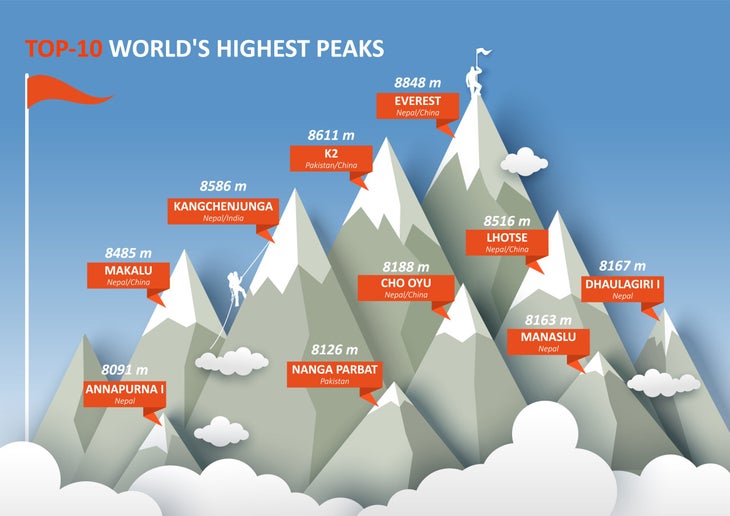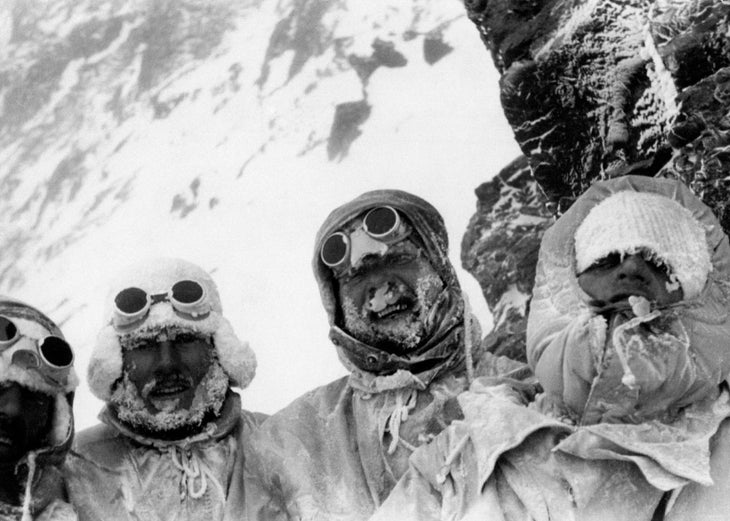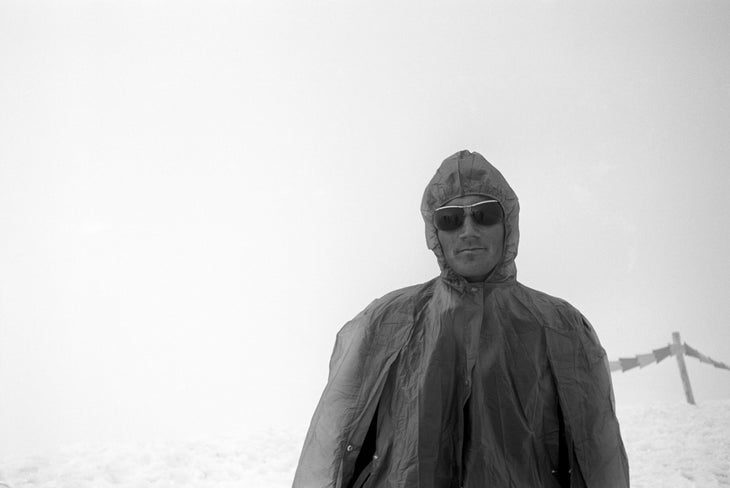Heading out the door? Read this article on the new Outside+ app available now on iOS devices for members! Download the app.
This article is part of Climbing’s online archives documenting climbing’s greatest mountains, such as Everest, and its pioneering practitioners such as Marc-Andre Leclerc.
K2 (8,611 meters/28,251 feet), or “Chogori,” is the world’s second highest mountain, after Everest (8,048 meters). Unlike Everest and the eight other highest mountains on Earth, K2 is not located in the Himalaya, however, but in Pakistan’s Karakorum. K2 is situated on the border of the Pakistani-Kashmir region Gilgit-Baltistan, and a slice of Kashmir administered by China as part of Xinjiang. All 14 of the world’s 8,000-meter peaks, and the vast majority of the 100 highest mountains on the planet, are located in either the Karakorum or Himalaya.
Also known as the “Savage Mountain,” K2 is generally considered among the most difficult of the world’s 8,000ers, and its death rate was historically one of the highest of all 14 mountains, along with Annapurna I (8,091 meters) and Nanga Parbat (8,126 meters). The former sits at a death rate of approximately 25%, while Parbat and K2 have traditionally held death rates in the low 20 percents. However, swarms of K2 ascents in recent years, notably in 2022, are contributing to lowering the K2’s overall death rate, which currently sits around 13%. K2 was the last of the 8,000-meter peaks to see a winter ascent (in 2021).
While its difficulty and technicality have traditionally deterred the swarms of amateur mountaineers that flock to Everest, K2 has rapidly commercialized in recent years. Overcrowding on the peak is becoming a concern, especially due to dangerous sections that lend themselves to traffic jams, like the Bottleneck Couloir (see below).
2022 saw over 190 summits as of July 30, smashing the previous yearly record of 62 [2018] by over three times. In addition, over 145 climbers summited in a single 24-hour period, on July 22. “The Everest model is now official on K2,” Himalayan chronicle Alan Arnette wrote in a July 2022 blog. “I [once] wrote that K2 would never become Everest … I was wrong.”

History
K2 was originally surveyed by a British team in 1856, christened K2 as it was the second main peak of the Karakorum that was mapped. The other principal Karakakorum summits were originally named likewise (K1, K3, K4, and K5), but today are known as Masherbrum (7,821 meters), Gasherbrum IV (7,925 meters), Gasherbrum II (8,035 meters), and Gasherbrum I (8,080 meters), respectively.
Oscar Eckenstein and notorious occultist Aleister Crowley spearheaded the first serious expedition to summit K2 in 1902, accompanied by Guy Knowles, Jules Jacot-Guillarmod, Heinrich Pfannl, and Victor Wessely. The team attempted the Northeast Ridge, battling brutal weather during their 68 days on the mountain. They reached approximately 21,407 feet after five attempts, setting a record for the longest period spent at such a high altitude. Following the failed expedition, Crowley notably declared that not the Northeast Ridge, but the Abruzzi Spur (Southeast Spur), was the mountain’s most viable line of ascent. This was the route eventually used by the peak’s first ascensionists and is today considered by far its easiest route.

The Italian Duke of the Abruzzi (Luigi Amedeo) led K2’s second expedition in 1909, but his team was driven back on the eponymous spur at 20,500 feet. They retargeted their efforts on first the peak’s west and then northeast ridges, but failed on both accounts. The peak wasn’t tried again for nearly two decades, until a 1938 American attempt led by Charles Houston, which reached 26,000 feet on the Abruzzi Spur but was turned back by foul weather and dwindling supplies.
Another American expedition the following year came only 600 feet from the summit, but climber Dudley Wolfe was left stranded high on the mountain after his teammates descended. Several attempts were made to rescue him, but he refused to come down. Eventually, three Sherpas, Pasang Kikuli, Pasang Kitar, and Phinsoo, disappeared high on the mountain during the third and final rescue attempt. Another expedition in 1953, led again by Houston, saw the team trapped for 10 days at 25,590 feet amid a violent storm, and ended in the death of a climber, Art Gilkey.
K2 was finally successfully summited on July 31, 1954, by an Italian team led by Ardito Desio. Team members Lino Lacedelli and Achille Compagnoni reached the summit via the Abruzzi Spur, and the expedition also included Pakistani colonel Muhammad Ata-Ullah, Hunza porter Amir Mehdi, and prominent climber Walter Bonatti. One member, Mario Puchoz, died of pneumonia.

Though successful, the expedition proved controversial, as Compagnoni and Lacedelli established their high camp (Camp IX) at an elevation nearly 1,000 feet higher than originally agreed with Mehdi and Bonatti, who were to portage the former duo’s oxygen tanks up to their camp prior to their summit bid. As it became too dark to descend by the time Mehdi and Bonatti reached the new drop point, the pair were forced to bivvy in the open, without sleeping bags, at 26,000 feet. Both survived, but Mehdi was hospitalized for months and lost nearly all of his fingers and toes to frostbite. It was later indicated that Compagnoni deliberately moved camp, due to a perceived rivalry with the younger Bonatti.

The second ascent did not take place until 23 years after Desio’s expedition when Ichiro Yoshizawa led a Japanese team to the summit, also by the Abruzzi Spur, on August 9, 1977. The first winter ascent of the mountain was on January 16, 2021, under a 10-man Sherpa team led by Nirmal “Nims” Purja.
As of August 2022, best estimates hold that approximately 700 climbers have summited K2, with 190 ascents (27% of all K2 climbs) occurring in the 2022 season alone. Approximately 96 individuals have died on the mountain to date, but the fatality rate, once nearly 25%, is much reduced from years past. In 2022, for example, only three climbers died on the mountain, 1.6% of successful summits.
Climbing Routes
By far the most popular route on K2 is the Abruzzi Spur, or the Southeast Ridge, which begins on the Pakistani side of the mountain. This is the same route that was used for the peak’s first ascent in 1954. Over 75% of all K2 climbers take this route, which follows a ridgeline beginning at around 17,700 feet. It presents several technical and exposed sections, including the 100-foot crack House’s Chimney and the Black Pyramid, a large arete protruding from the main spur. Another well-known feature is the Bottleneck Couloir, a slope approximately 1,300 feet below the summit, which is overhung by a number of unstable seracs.
The second-most-popular route is the Cešen, which runs just west of the Abruzzi Spur. It was pioneered by Slovenian climber Tomo Česen, who soloed the line in 1984 to 26,000 feet. The Česen avoids some of the technical obstacles lower down on the Abruzzi, but is significantly steeper and features increased rockfall and avalanche risk. It connects with the Abruzzi Spur around 60% of the way up the peak.
Other routes on K2 include the Northeast Ridge, North Ridge, South Face (or Central Rib), Southwest Pillar (Magic Line), Northwest Face, and Northwest Ridge. The East Face of K2 has famously never seen an ascent, likely due to the instability of its ice and snow formations.
Facts and Figures
- Elevation: 8,611 meters/28,251 feet
- Range: Karakorum, Kashmir, Pakistan/China
- First ascent: July 31, 1954.
- First ascentionists: Lino Lacedelli and Achille Compagnoni
- Cumulative successful summits: 706 (approximate)
- Cumulative deaths: 96
- Approximate fatality rate: 13.6%
- Average cost to climb: $30,000